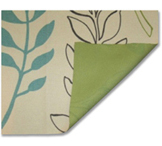Airdye is a water-less dye process for synthetic fabrics and materials. AirDye technology eliminates hazardous wastewater as a byproduct of dyeing fabric. Water scarcity affects one in three people on every continent and the world bank assumes 30% of all water pollution is fabric production related.
Depending on the fabric, and type of dyeing, AirDye uses up to 95% less water, and up to 86% less energy, contributing 84% less to global warming, according to an independent assessment.
Colorep claims that its AirDye Process is priced competitively compared to traditional technology also because of the better controllable process and quality, 10% of vat-dyed fabric is damaged during the process, whereas with AirDye, only 1% is damaged. The fact that no screens are needed makes that the leadtime is shorter giving the freedom of wait longer to decide what color or print to put onto their fabric, which would reduce the need for apparel makers to guess what colors consumers will want to wear months ahead. Additionally, some companies state that with AirDye technology they can print to order which eliminates production of unsold stock, excess and waste.
The AirDye process manufactures fabric that can be washed at any temperature, with whites or colors, with or without bleach. Because the AirDye process injects the dyes in the fabric and not on the fabric, bleach and cleaning agents do not affect them.
Fabrics dyed with AirDye technology supposedly feel no different than conventionally dyed textiles. It gives the designer great freedom since they can be dyed all one color, a different color on each side, a pattern on one side and a solid color on the other, or a pattern on both sides.

Comments by our Users
Be the first to write a comment for this item.